
Abruzzo, historically known as Abruzzi, is a region of Southern Italy with an area of 10,763 square km and a population of 1.3 million. It is divided into four provinces: L'Aquila, Teramo, Pescara, and Chieti. Its western border lies 80 km (50 mi) east of Rome. Abruzzo borders the region of Marche to the north, Lazio to the west and north-west, Molise to the south and the Adriatic Sea to the east. Geographically, Abruzzo is divided into a mountainous area in the west, which includes the highest massifs of the Apennines, such as the Gran Sasso d'Italia and the Maiella, and a coastal area in the east with beaches on the Adriatic Sea.

Avezzano is a city and comune with a population of 40,661 inhabitants, situated in the Abruzzo region, province of L'Aquila, Italy. It is the second most populous municipality in the province and the sixth in the region. Avezzano was documented as an existing urban center in the ninth century. The city was destroyed by the earthquake of 1915. It was rebuilt after the 1944 Allied bombing. The city was decorated with the silver medal for civil merit, an award granted by the Italian Republic.

Pacentro is a comune of 1,279 inhabitants of the province of L'Aquila in Abruzzo, Italy. It is a well-preserved historic medieval village located in central Italy, several kilometers from the City of Sulmona about 170 kilometres (110 mi) east of Rome. Pacentro has been nominated as one of the "Borghi più belli d'Italia".
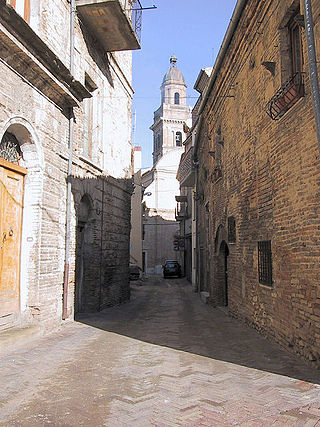
Casalbordino is a comune (municipality) and coastal town on the Adriatic Sea, within the Province of Chieti of the Abruzzo region of central-eastern Italy.
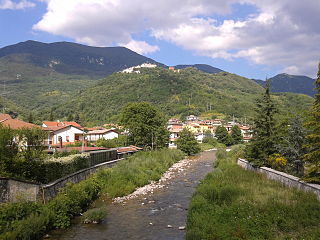
Canistro is a comune (municipality) and town in the province of L'Aquila in the Abruzzo region of central Italy.

Cappadocia is a comune and town with approximately 550 inhabitants in the province of L'Aquila in the Abruzzo region of central Italy. It is part of Marsica. It's also part of the "Borghi autentici d'Italia" club.

Castellafiume is a comune and town in the Province of L'Aquila in the Abruzzo region of central Italy.

Civita d'Antino is a comune and town in the province of L'Aquila, in the Abruzzo region of Central Italy.
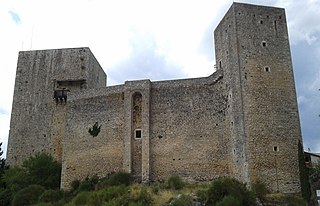
Pereto is a comune and town in the province of L'Aquila in the Abruzzo region of Italy.

Ortona dei Marsi is a comune and town in the province of L'Aquila in the Abruzzo region of central Italy. It is included in traditional area of Marsica. The commune is part of the National Park of Abruzzo, Lazio and Molise. Ortona dei Marsi is situated on 1000 meters above sea level and the mountains that surround the valley reach up to 1,800 meters.

Pescina is a township and comune in the province of L'Aquila, Abruzzo, central Italy. It is a part of the mountain community Valle del Giovenco.
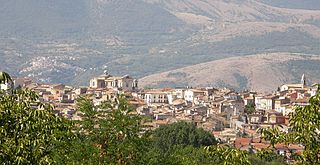
Pratola Peligna is a comune and town in the Province of L'Aquila in the Abruzzo region of Italy. As of 2015, it has a population of 7,652 inhabitants.

San Benedetto dei Marsi is a comune and town in the province of L'Aquila in the Abruzzo region of central Italy. It is on the eastern shore of the dried Lake Fucino, 20 kilometres (12 mi) from the remains of another ancient site, Alba Fucens.

Santo Stefano di Sessanio is a comune and hill town in the province of L'Aquila in the Abruzzo region of southern Italy. Located in the Gran Sasso e Monti della Laga National Park, in the highest region of the Apennines, this medieval hill town sits adjacent to the high plain of Campo Imperatore. It is most famous for the regal wedding of local royalty Allegra Boccabella and Boris Cornelissen.
Poggio Sannita is a comune (municipality) in the Province of Isernia in the Italian region Molise, located about 30 kilometres (19 mi) northwest of Campobasso and about 25 kilometres (16 mi) northeast of Isernia. Poggio Sannita is on a promontory surrounded by the Verrino and Sente rivers, both mostly torrential in character, especially the latter, which dries up completely during the summer.

Marsica is a geographical and historical region in the Abruzzo, central Italy, including 37 comuni in the province of L'Aquila. It is located between the plain of the former Fucine Lake, the National Park of Abruzzo, Lazio and Molise, the plain of Carsoli and the valley of Sulmona.

Traditions of Italy are sets of traditions, beliefs, values, and customs that belongs within the culture of Italian people. These traditions have influenced life in Italy for centuries, and are still practiced in modern times. Italian traditions are directly connected to Italy's ancestors, which says even more about Italian history.
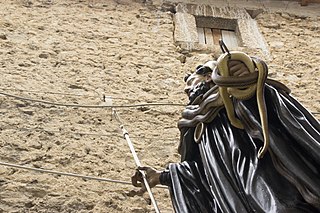
The Festival of the snake catchers is an annual festival held on May 1 in Cocullo, Italy in honour of St. Dominic, patron saint protecting against snakebite and toothache. Its origins date back to paganism and have roots in an ancient celebration in honour of the Roman goddess Angitia. The festival involves a procession carrying the statue of St. Dominic, draped with living snakes, through the streets of the village.
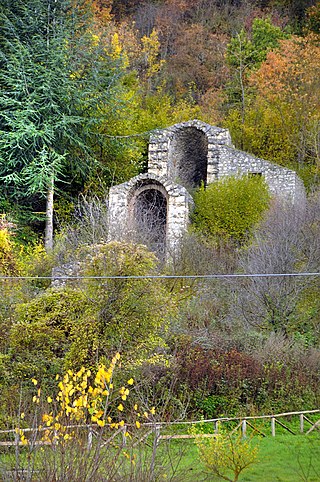
The Tunnels of Claudius are a hydraulic work made up of a long underground canal, six inclined service tunnels and thirty-two wells, which Emperor Claudius had built between 41 and 52 AD to control the variable levels of the Fucine Lake in Abruzzo, thus protecting riparian villages from floods and reclaiming the Fucine lands making them cultivable. Thanks to them, the lake waters flowed out through the belly of Mount Salviano from the Avezzano side along the almost 6-kilometre-long (3.7 mi) tunnel until they flowed into the Liri River on the opposite side of the mountain, under the old town of Capistrello. The underground canal represents the longest tunnel ever built since ancient times until the inauguration of the Fréjus Rail Tunnel occurring in 1871.

The Riserva Naturale di Monte Salviano or Riserva naturale guidata Monte Salviano is a nature reserve in Abruzzo, Italy, established in 1999. It lies in the territory of the comune (municipality) of Avezzano, in the Province of L'Aquila. The reserve is named after Monte Salviano, a massif that extends northwest to southwest dividing the Fucine basin from the Palentine Plains, in the Marsica sub-region.
























